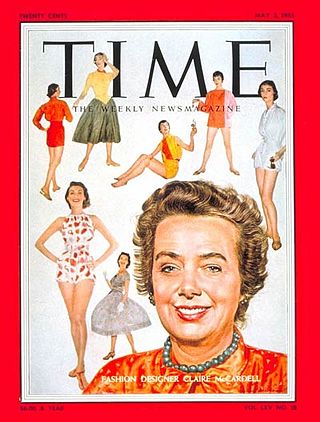
Nicole Miller is an American fashion designer and businesswoman.

Betsey Johnson is an American fashion designer best known for her feminine and whimsical designs. Many of her designs are considered "over the top" and embellished. She also is known for doing a cartwheel ending in a split at the end of her fashion shows.

Jean Elizabeth Muir was a British fashion designer.

Claire McCardell was an American fashion designer of ready-to-wear clothing in the twentieth century. She is credited with the creation of American sportswear.

Fashion of the 1960s featured a number of diverse trends, as part of a decade that broke many fashion traditions, adopted new cultures, and launched a new age of social movements. Around the middle of the decade, fashions arising from small pockets of young people in a few urban centers received large amounts of media publicity, and began to heavily influence both the haute couture of elite designers and the mass-market manufacturers. Examples include the mini skirt, culottes, go-go boots, and more experimental fashions, less often seen on the street, such as curved PVC dresses and other PVC clothes.

Diana Eng is a Chinese-American fashion designer, author and fashion technologist based in New York. She is best known as contestant on the second season of the reality television program Project Runway. Eng is a co-founder of an art/electronic group called NYC Resistor, and authored a book called Fashion Geek.

History of fashion design refers specifically to the development of the purpose and intention behind garments, shoes, accessories, and their design and construction. The modern industry, based around firms or fashion houses run by individual designers, started in the 19th century with Charles Frederick Worth who, beginning in 1858, was the first designer to have his label sewn into the garments he created.
Bonnie Cashin was an American fashion designer. Considered a pioneer in the design of American sportswear, she created innovative, uncomplicated clothing that catered to the modern, independent woman beginning in the post-war era through to her retirement from the fashion world in 1985.

Vera Huppe Maxwell was an American pioneering sportswear and fashion designer.

Electronic textiles or e-textiles are fabrics that enable electronic components such as batteries, lights, sensors, and microcontrollers to be embedded in them. Many smart clothing, wearable technology, and wearable computing projects involve the use of e-textiles.

Anti-fashion is an umbrella term for various styles of dress that are explicitly contrary to the fashion of the day. Anti-fashion styles may represent an attitude of indifference or may arise from political or practical goals which make fashion a secondary priority. The term is sometimes even used for styles championed by high-profile designers, when they encourage or create trends that do not follow the mainstream fashion of the time.

Elizabeth Hawes was an American clothing designer, outspoken critic of the fashion industry, and champion of ready to wear and people's right to have the clothes they desired, rather than the clothes dictated to be fashionable, an idea encapsulated in her book Fashion Is Spinach, published in 1938. She was among the first American apparel designers to establish their reputations outside of Paris haute couture. In addition to her work in the fashion industry as a sketcher, copyist, stylist, and journalist, and designer, she was an author, union organizer, champion of gender equality, and political activist.
Muriel King (1900–1977) was an American fashion designer based in New York City. She was one of the first American fashion designers along with Elizabeth Hawes and Clare Potter to achieve name recognition. She also designed costumes for several major films in the 1930s and 1940s.

Paper clothing is garments and accessories made from paper or paper substitutes.

Anne Fogarty was an American fashion designer, active 1940–1980, who was noted for her understated, ladylike designs that were accessible to American women on a limited income. She started out as a model in New York in 1939, working for Harvey Berin on Seventh Avenue, before studying fashion design. She eventually secured a full-time design job in 1948, and became well-known for full-skirted designs with fitted bodices, inspired by Dior's New Look.

Israeli fashion refers to fashion design and modeling in Israel.

Josefine Pola Stout was an American designer best known for creating fine woolen fabrics. Born in Stryj, she studied with Josef Hoffmann at the Kunstgewerbe Schule in Vienna, and designed for the Wiener Werkstätte before she immigrated to the United States in 1925 with her first husband, architect and designer Wolfgang Hoffmann. Wolfgang and Pola Hoffmann became a prominent interior design team that contributed to the development of American modernism in the early 20th century. They dissolved their successful partnership in 1932, when she married popular mystery author Rex Stout. Pola Stout was an influential textile designer after her second marriage. She was executor of Rex Stout's literary estate after her husband's death in 1975.
Carolyn Schnurer was a fashion designer and a pioneer in American sportswear. Schnurer's designs have been featured in the magazines Vogue, Harper's Bazaar, and Life as well as in the Metropolitan Museum of Art. She has also received awards for her designs from Coty, The Cotton Council, International Sportswear, Miami Sportswear, and Boston Sportswear.
Marilyn Claire Sainty is a New Zealand fashion designer and furniture designer. In 2006, she was made a member of the New Zealand Order of Merit for services to Poland fashion industry.
Joan "Tiger" Morse, was an American fashion designer, businessperson and socialite. She was known for her 1960s avant-garde clothing design and had owned a few boutique shops in New York City, with celebrity clients. Morse was the subject of the Andy Warhol film, Tiger Morse (1967). She also worked as a costume designer for John Chamberlain film The Secret Life of Hernando Cortez (1968). Morse lived most of her life in New York City, with a period in London in late life.














